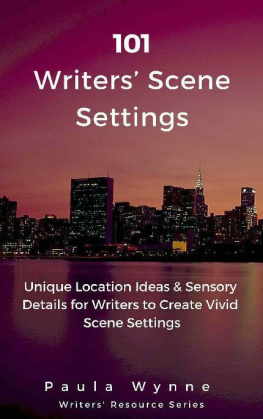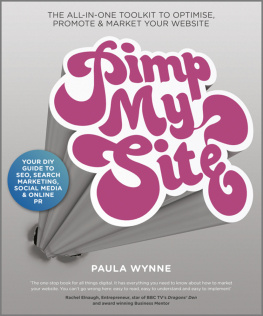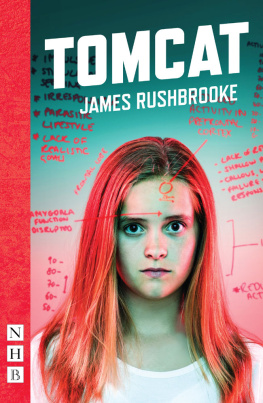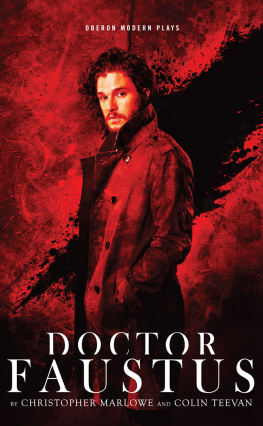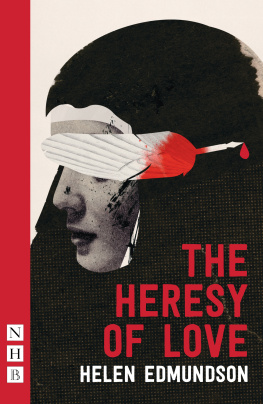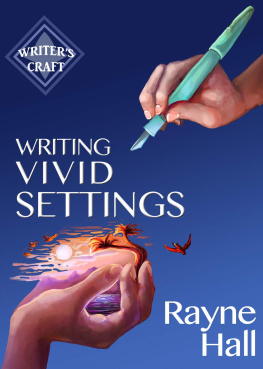Contents
101 Writers Scene Settings
Unique Location Ideas & Sensory
Details for Writers to Create
Vivid Scene Settings
Writers Resource Series
Paula Wynne
Prado Press
London, United Kingdom
Copyright 2016 by Paula Wynne.
Paula Wynne/Prado Press
United Kingdom
www.paulawynne.com
Ordering information: Special discounts are available on quantity purchases. For details contact the author via
First published by Prado Press 2016
24 Caunter Road, Newbury, Berkshire, RG14 1QZ
101 Writers Scene Settings/ Paula Wynne -- 1st edition
First Published 2016 by Prado Press
ISBN: ISBN-13: 978-1530608492
ISBN-10: 153060849X
Cover Art: Paula Wynne and Kent Wynne
Editor: Betsy Smith
All rights reserved. No part of this publication may be reproduced, distributed or transmitted in any form or by any means, including photocopying, recording, or other electronic or mechanical methods, without the prior written permission of the publisher, except in the case of brief quotations embodied in reviews and certain other non-commercial uses permitted by copyright law.
The rights of Paula Wynne as author have been asserted in accordance with the Copyright, Designs and Patents Act 1988. A CIP catalogue record for this book is available from the British Library.
Also by Paula Wynne
Create a Successful Website
Pimp My Site
Writers Resource Series
Pimp My Fiction
A~Z of Writers Character Quirks
101 Writers Scene Settings
Torcal Trilogy
The Grottos Secret
Grab a Free Copy of
Pimp My Fiction
Secrets of writing a successful novel using techniques from the best reference guides on creative writing.
* Improve your writing
* Transform your novel into a page-turning best seller
* Ensure your success as a novelist
Pick up your free copy: http://eepurl.com/bC336f
Dedication
To novelists who write about locations so their readers can go to special, magical places that seep into them, capture their imagination, and make them remember that setting long after they have left.
The writer operates at a peculiar crossroads where time and place and eternity somehow meet.
His problem is to find that location.
Flannery OConnor
Foreword
One of the most overlooked elements in first novels by authors is setting. Often setting is thought of as boring or something a writer should hurry up and get done with in order to move to the real storythe plot of the novel or purpose of a scene.
But setting is not only essential for transporting the reader into the world of story; its necessary to bring cohesion to a scenes unfolding. If a reader doesnt know where the characters are or what it looks and feels like, she might get confused or stop reading.
As a professional writing coach, I critique more than two hundred manuscripts a year, and many (perhaps most) of those are strongly lacking in setting. Im often asking, Where does this scene take place? and What does the scenery look and smell and feel like? Settings evoke moods and can be used powerfully in novels to reveal character and complicate plot developments.
So 101 Writers Scene Settings is a welcome addition to the resource shelf for writers. Paula Wynne takes special care in this book to explore a wide variety of setting possibilities for scenes, some of which include settings based on the type of terrain or scenery as well as unique aspects to a setting (tight and narrow places, for example).
Reading about these different types of settings can spark ideas and help writers envision and get a sense of places theyve never been.
Paula gives tips on what elements should be included when describing settings (mood, colours, weather) and the kinds of physical details one might notice.
Also important are the backstory, genre, and character history and personality that might be impacted or impact a particular setting.
With each setting listing, Paula suggests general, mood, and item details. These very specific locations with their own unique stories and histories help writers to not just immerse themselves in the places she suggests but also to envision similar settings of their own that will be just right for their story.
While there are of course thousands of other potential settings for story scenes, 101 Writers Scene Settings provides plenty of creative, unique places that will undoubtedly give writers all they need to create sensory-rich settings. Put this book on a special place on your shelfnear your desk so you can refer to it often!
C. S. Lakin, author of The Writers Toolbox Series
Introduction
Were not lost. Were locationally challenged.
John M. Ford
Scene settings are critical pieces of the puzzle that will eventually make up your entire novel.
It might be new novel settings that you require, or maybe you need to vamp up current scene locations that are not fitting snugly into the rest of your plot.
Most of the time, writers and authors use locales that they know, so their scene settings naturally come with a sense of familiarity and comfort. But what about exciting readers with new places for them to experience through the characters? After all, the reason readers read is to travel to new places, meet new people, and experience new emotionsall through the stories created in someone elses mind.
As writers we are taught that everything in our scenes must be seen through the eyes of our POV characters. This is vitally important when looking at your novels scene settings. Your hero may love a certain place, but someone else, possibly your villain, will hate it. You may experience that same love/hate experience as you browse through this list of settings ideas. More importantly, 101 Writers Scene Settings is aimed at helping you to determine whether a particular setting may work for your story, or perhaps it may inspire some new ideas of your own.
Dont Just Write a SceneCreate a Memorable Setting
Make your novels scene settings come alive to your readers with mood, senses, atmosphere, and vivid descriptions shown through the point of view of your characters. This book will guide you through choosing settings with mood, atmosphere, and sensory details that will influence your characters.
In films that feature characters like Jason Bourne or James Bond, you see baddies chasing the hero through crowded towns with tight corners and narrow streets, or racing across rooftops. In other classic films you may see the most unusual places on earth and wonder how the studios found those places to feature in their films.
Many have unrestricted budgets and numerous bodies to act as scouts for locations. But what if there was a resource that writers could dip in and out of to find these special types of locations for setting their scenes?
101 Writers Scene Settings will guide you through
creating a novel setting in order to write a vivid scene.
finding unique locations for different scenarios in your plot.
creating vivid descriptions for your scene setting, and weaving them together seamlessly through the characters actions and reactions.
developing all the elements within a location to ensure you write realistic, intriguing descriptions shown from your characters point of view
using sensory details that bring your setting to life.
creating layers of details that make readers feel as though they are right there with your character.
To make your search even more convenient, you will get a free download copy of the Settings Checklist!
Filled with categories of ideas for settings such as crowded towns, tight and narrow streets, adventure-filled locations, places up high and down low, mountains and valleys, seascapes, abandoned places, modern techno settings, scary and spooky environments, and unusual work places, homes, and gathering places, 101 Writers Scene Settings helps you to dive into the researching and planning of your settings so that you can easily put together a compelling scene and create a vivid setting that readers wont forget.
Next page
